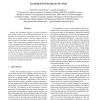Free Online Productivity Tools
i2Speak
i2Symbol
i2OCR
iTex2Img
iWeb2Print
iWeb2Shot
i2Type
iPdf2Split
iPdf2Merge
i2Bopomofo
i2Arabic
i2Style
i2Image
i2PDF
iLatex2Rtf
Sci2ools
CIMCA
2005
IEEE
2005
IEEE
Learning to feel the physics of a body
Despite the tremendous progress in robotic hardware and in both sensorial and computing efficiencies the performance of contemporary autonomous robots is still far below that of simple animals. This has triggered an intensive search for alternative approaches to the control of robots. The present paper exemplifies a general approach to the self-organization of behavior which has been developed and tested in various examples in recent years. We apply this approach to an underactuated ”snake” like artifact with a complex physical behavior which is not known to the controller. Due to the weak forces available, the controller so to say has to develop a kind of feeling for the body which is seen to emerge from our approach in a natural way with meandering and rotational collective modes being observed in computer simulation experiments.
CIMCA 2005 | Complex Physical Behavior | Contemporary Autonomous Robots | Rotational Collective Modes |
| Added | 24 Jun 2010 |
| Updated | 24 Jun 2010 |
| Type | Conference |
| Year | 2005 |
| Where | CIMCA |
| Authors | Ralf Der, Frank Hesse, Georg Martius |
Comments (0)

